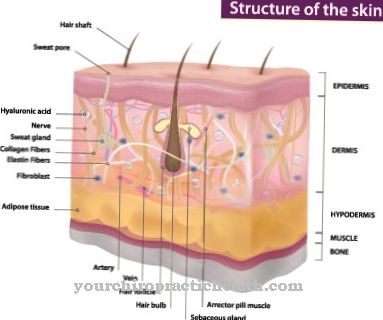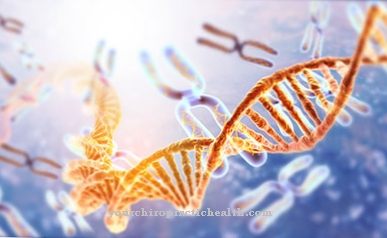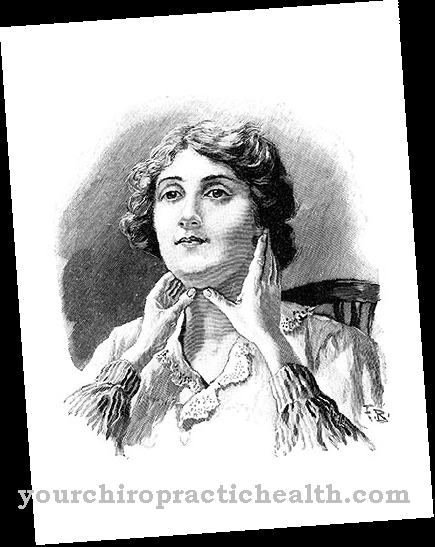A Duodenal stenosis is a narrowing of the small intestine. It is usually congenital, but it can also be acquired.
What is duodenal stenosis?

© Avanne Troar - stock.adobe.com
A stenosis is a narrowing of a hollow organ. In duodenal stenosis, the small intestine, more precisely the duodenum (duodenum), is affected by the stenosis. The duodenal stenosis is also often called Duodenal atresia where atresia is just one form of stenosis. Anatomically, the stenosis is subdivided according to its position in relation to the greater duodenal papilla.
In the case of high obstruction, the closure is above the father's papilla. The father's papilla (also papilla duodeni major) lies just above the confluence of the main bile duct and the pancreatic duct in the duodenum. A stenosis that lies beneath the father's papilla is called a deep obstruction.
The congenital form of duodenal stenosis occurs on average in 1 in 7,000 children. Duodenal stenosis is often combined with other malformations. One third of all children with congenital duodenal stenosis also have trisomy 21. Trisomy 21 is also known as Down syndrome.
causes
Duodenal stenosis can be congenital or acquired. External stenoses are usually caused by compression. The most common cause is malrotation. Malrotation is a disruption of the rotation of the large and small intestines in the development of the embryo. The abnormal position leads to a compression of the duodenum by the large intestine. The annular pancreas can also cause duodenal stenosis.
It is a malposition of the pancreas (pancreas). The dorsal and ventral parts of the pancreas are not completely fused together, so two lobes are formed. This creates a ring around the small intestine. The lumen of the duodenum can be narrowed through this ring. Depending on the extent of the disability, the undesirable development is already noticeable in the womb.
Slight constrictions can also only be noticed in the third or fourth decade of life. Another cause of duodenal stenosis is Ladd's syndrome. It is a congenital volvulus, a rotation of a section of the digestive tract. Furthermore, braces can narrow the duodenum. Brides are strands of scars that lie at the height of the abdomen. In general, clamps are also referred to as adhesions. They mostly arise after operations.
More rarely, duodenal stenosis is caused by atypical blood vessels. Atypically, the portal vein can run directly in front of the duodenum. The superior mesenteric vein syndrome is an example of such an anomaly. Other external causes of stenosis are intestinal duplicates or diverticula. In the case of an intestinal duplication, one part of the intestine is duplicated in the mesentery. Diverticula are sac-shaped protrusions on the intestinal wall.
Internal stenoses are caused by a narrow tubular segment. Ring-shaped narrowing or connective tissue changes in the intestinal wall can also have a slowly increasing stenosis effect. In duodenal atresia, the lumen of the small intestine is absent or insufficiently developed due to a malformation of the duodenal canal.
You can find your medication here
➔ Medicines for constipation and intestinal problemsSymptoms, ailments & signs
The symptoms of duodenal stenosis depend on the extent of the disorder. Mild duodenal stenosis may go unnoticed for a lifetime. Intrauterine polyhydramnios may occur during pregnancy. Severe duodenal stenosis occurs as a result of massive vomiting in the first few days of life.
The upper abdomen of the affected children is bulging, but the lower abdomen is drawn in. Symptom-free periods are also possible. The diagnosis may even be made in school or adulthood. If the stenosis is below Father's papilla, patients vomit bile.
Green vomiting is a typical symptom of duodenal stenosis. Often the stenosis is also associated with esophageal atresia or anal atresia. It is not uncommon to find a heart defect in addition to the stenosis. The children are also often affected by Down's syndrome.
Diagnosis & course
In severe duodenal stenosis, the suspected diagnosis can be made based on the symptoms. If there is a suspicious ultrasound examination of the child's abdomen in the womb, the diagnosis can be confirmed by X-rays after birth. The so-called double-bubble phenomenon becomes visible in the ultrasound examination. The child's stomach is filled with fluid and forms the first bubble.
The duodenum also contains fluid and thus appears as a second bladder. Since the stomach and duodenum are next to each other in the picture, a double-bubble appears. The same phenomenon can be seen in the X-ray image. The upper gastrointestinal tract fills with air after birth. One air bubble forms in the stomach, the second bubble forms in the duodenum. Since the rest of the gastrointestinal tract is empty, the double bubble phenomenon is also visible here.
Complications
Duodenal stenosis does not necessarily have to lead to complications. If the duodenal stenosis is very mild, the patient may not notice it at all. There are no complaints, restrictions or complications.
Life is then not influenced by the duodenal stenosis and life expectancy is not reduced either. If the duodenal stenosis is widespread, vomiting and abdominal pain occur in many cases. In many cases, the disease also causes a heart defect. Very often people with Down syndrome in particular are affected by duodenal stenosis, which further restricts their life.
Treatment is usually possible and, in many cases, successful. There are no particular complications. The treatment is often carried out in childhood. However, if the child is also affected by other malformations, the duodenal stenosis may not be easily treated. The further complications depend heavily on the syndrome with which the child is born. Unfortunately, there is no way to prevent the symptom.
When should you go to the doctor?
In the case of duodenal stenosis, a doctor does not have to be consulted in every case. If the disorder itself does not lead to discomfort or other unpleasant feelings, no medical treatment is required. However, a doctor should be consulted if the person concerned suffers from severe and, above all, persistent vomiting and also from nausea. A bulging abdomen can also indicate duodenal stenosis and should be examined. A doctor should be consulted immediately, especially when vomiting bile fluid.
In many cases, the disease is also associated with a heart defect, so a cardiologist should also be seen when diagnosing duodenal stenosis. As a rule, the person concerned then has to take part in regular examinations to prevent further complaints. The disease itself can be diagnosed by an internist. In an emergency, an emergency doctor can be called or the hospital can be visited. The disease can be treated relatively easily and the person concerned does not suffer from a reduced life expectancy.
Doctors & therapists in your area
Treatment & Therapy
If there is duodenal stenosis with a membrane, treatment may be endoscopic. Otherwise there will be operative intervention. One possible procedure is the duodenoduodenostomy. A duodenojejunostomy can also be performed. Part of the small intestine is removed and the remains of the duodenum are surgically joined to the jejunum.
Depending on the severity of the stenosis, a membrane excision can also be performed. The prognosis depends on several factors. On the one hand, the severity of the stenosis plays a role. The birth weight and the severity of additional malformations or deformities also have a decisive influence on the prognosis. Children with a birth weight less than 2000 grams or children with a birth weight between 2000 and 2500 grams and with severe deformities have the worst chance of a complete cure.
Outlook & forecast
Patients with duodenal stenosis usually have a good prognosis. In mild cases, no treatment needs to be taken. The food supply is adapted to the needs of the organism so that there are no complications during bowel movements.
If symptoms arise, treatment should be carried out so that no consequential damage or life-threatening situations occur. The congenital or acquired narrowing of the small intestine is corrected in a surgical procedure. After the wound has healed, the patient can be discharged from the treatment without any symptoms. The correction ensures that the intestine functions permanently. No further action needs to be taken. The healing process depends on the severity of the constriction.
The more extensive the procedure, the longer it will take to recover. If the wound is not properly cared for, the risk of disease increases. In severe cases, sepsis occurs. In the case of congenital duodenal stenosis, infants with a low birth weight of less than 2,000 grams have an unfavorable prognosis.
The corrective intervention is often not coped well with your body and causes excessive demands. In addition, the prospect of complete healing in patients with particularly severe malformations is diminished. It is often not possible for the doctors to correct all abnormalities. There are still deformities that continue to cause complaints.
You can find your medication here
➔ Medicines for constipation and intestinal problemsprevention
In most cases, duodenal stenosis is congenital. The exact mechanisms of its formation are unknown. Prevention of the disease is therefore not possible.
Aftercare
First and foremost, duodenal stenosis always requires medical examination and treatment. There are only very limited follow-up options available to those affected, so that an early diagnosis is very important in the first place. The earlier the duodenal stenosis is detected, the better the further course of the disease is usually.
A doctor must therefore be consulted at the first signs of the disease. The treatment of the disease is carried out by a surgical procedure in which part of the intestine is removed. After this procedure, the patient should definitely stay in bed and not exert himself unnecessarily.
Stressful or physical activity should also be avoided in order not to slow down healing. Furthermore, heavy food must not be consumed in order not to overwhelm the stomach and intestines. The patients are dependent on a light and gentle diet, although normal food intake can only be carried out after a successful recovery.
However, the duodenal stenosis may not always be completely healed. In many cases, the parents are therefore dependent on psychological treatment, although discussions with friends and family can also be very useful.
You can do that yourself
Duodenal stenosis is usually caused by a genetic malposition of the small intestine and is associated with Down syndrome (trisomy 21) in around 30 percent of cases. In less common cases, the constriction in the duodenum can also be acquired through an accident or after an operation. Depending on the type of malposition, the passage of the intestinal contents can only be slightly or significantly impeded.
The symptoms are correspondingly different. They range from unnoticeable to frequent severe vomiting and severe abdominal pain in the first days of life. In principle, this also applies to duodenal stenosis that is only acquired at a later age. In the case of only minor symptoms that do not make an immediate surgical intervention necessary, a change to an easily digestible diet with a balanced proportion of indigestible fiber is recommended as an adjustment in everyday life and as a self-help measure.
The easily digestible food supports a quick intestinal passage so that the constriction in the small intestine remains symptom-free and no further restrictions in everyday life are to be expected. In addition, the food pulp that reaches the small intestine directly from the stomach can be diluted a little with a sufficient amount of water, which also supports the rapid passage of the constriction in the small intestine.
Self-help measures are insufficient if the symptoms are severe. In these cases - especially in the case of newborns - an operation is usually necessary to avoid life-threatening consequential damage.
























.jpg)



